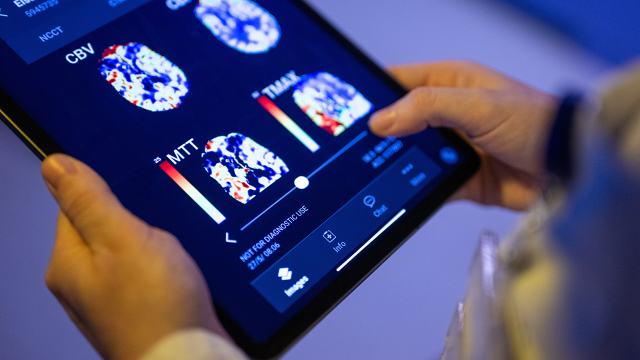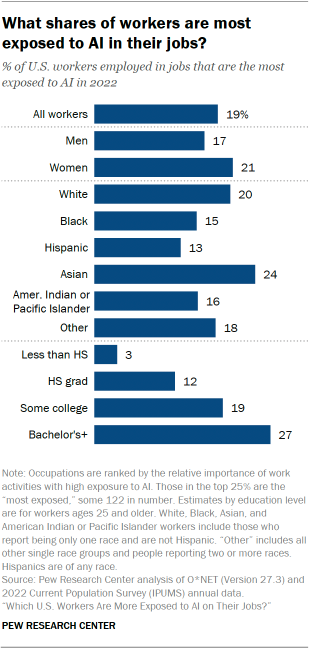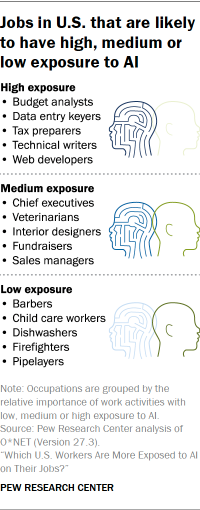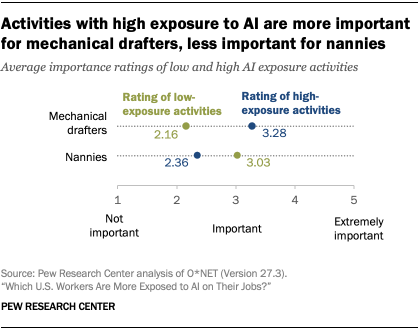About a fifth of all workers have high-exposure jobs; women, Asian, college-educated and higher-paid workers are more exposed. But those in the most exposed industries are more likely to say AI will help more than hurt them personally

Pew Research Center conducted this study to understand how American workers may be exposed to artificial intelligence (AI) at their jobs. The study emphasizes the impact of AI on different groups of workers, such as men and women and racial and ethnic groups, and it includes new survey findings on how American adults think AI will impact them personally, setting it apart from preceding analyses.
By exposure to AI, we refer to the likelihood that the activities workers perform on their jobs may be replaced or aided by artificial intelligence. We make no determination as to whether workers may lose their jobs as a result or gain new jobs, and we also do not consider the role of robots.
Most of the analysis is based on data from the Occupational Information Network (O*NET), Version 27.3. O*NET analysts rate the importance of 41 work activities related to job performance in individual occupations. We grouped these activities into three categories based on their likely exposure to AI: low exposure, medium exposure and high exposure. Occupations were ranked by the relative importance of low- or high-exposure activities. Those in the top quarter of each ranking are the least or most exposed occupations. The remaining occupations have medium exposure.
Data on the employment and earnings of workers in individual occupations and their demographic profiles are from the Current Population Survey (IPUMS). Monthly files from January to December 2022 were combined to form an annual file. Earnings data is available for a quarter of this sample. The AI-exposure rankings of 873 detailed occupations from the O*NET data are matched to 485 broader occupations listed in the CPS.
A part of the analysis is based on a Pew Research Center survey of 11,004 U.S. adults conducted from Dec. 12 to 18, 2022. Everyone who took part in the survey is a member of the Center’s American Trends Panel (ATP), an online survey panel that is recruited through national, random sampling of residential addresses. This way, nearly all U.S. adults have a chance of selection. The survey is weighted to be representative of the U.S. adult population by gender, race, ethnicity, partisan affiliation, education and other categories. Read more about the ATP’s methodology.
Here are the questions used for this report, along with responses, and its methodology.
Artificial intelligence (AI): Broadly speaking, AI refers to a range of applications of machine learning, computer vision and natural language processing that allow computers or machines to perform tasks autonomously. AI can substitute for or complement a variety of human tasks, such as writing, drawing, providing customer service, reading radiology scans, driving cars and more. ChatGPT and Dall-E are examples of AI-driven technologies.
Low or high exposure to AI: We rated a set of 41 job-related work activities common to all occupations as having low, medium or high exposure to AI. How much an occupation is exposed to AI depends on which of these work activities is more important in that particular job. The importance scale runs from one (not important) to five (extremely important). In this report, we focus on the importance of low- and high-exposure activities. In one step of analysis, occupations are ranked by the relative importance of high-exposure activities in them; the jobs ranking in the top 25% are occupations that we rate as most exposed to AI. In another step, occupations are ranked by the relative importance of low-exposure activities in them. Those ranking in the top 25% are occupations that are least exposed to AI. A full description of the ranking process is in the methodology.
The terms occupation and job are often used interchangeably in the report, as are the terms earnings and wages.
White, Black, Asian and American Indian or Pacific Islander workers include those who report being only one race and are not Hispanic. Hispanics are of any race.
High school graduate refers to those who have a high school diploma or its equivalent, such as a General Education Development (GED) certificate, and those who had completed 12th grade, but their diploma status was unclear (those who had finished 12th grade but not received a diploma are excluded). Adults with some college include those with an associate degree and those who attended college but did not obtain a degree.
U.S. born refers to individuals who are U.S. citizens at birth, including people born in the 50 U.S. states, the District of Columbia, Puerto Rico or other U.S. territories, as well as those born elsewhere to at least one parent who is a U.S. citizen. The terms foreign born and immigrant are used interchangeably in this report. They refer to people who are not U.S. citizens at birth.
Artificial intelligence (AI) recently gained new attention with the release of ChatGPT and Dall-E. These tools and the broader array of AI-driven business applications represent a new reality for workers.

Historically, changes in technology have often automated physical tasks, such as those performed on factory floors. But AI performs more like human brainpower and, as its reach grows, that has raised questions about its impact on professional and other office jobs – questions that Pew Research Center seeks to address in a new analysis of government data.
What we found
- In 2022, 19% of American workers were in jobs that are the most exposed to AI, in which the most important activities may be either replaced or assisted by AI.
- 23% of workers have jobs that are the least exposed to AI, in which the most important activities are farther from the reach of AI. Other workers, nearly six-in-ten in all, are likely to have varying levels of exposure to AI.
- Jobs with a high level of exposure to AI tend to be in higher-paying fields where a college education and analytical skills can be a plus.
Certain groups of workers have higher levels of exposure to AI
- Those with more education: Workers with a bachelor’s degree or more (27%) are more than twice as likely as those with a high school diploma only (12%) to see the most exposure.
- Women: A greater share of women (21%) than men (17%) are likely to see the most exposure to AI. This is because of differences in the types of jobs held by men and women.
- Asian and White: Asian (24%) and White (20%) workers are more exposed than Black (15%) and Hispanic (13%) workers.
- Higher-wage workers: In 2022, workers in the most exposed jobs earned $33 per hour, on average, compared with $20 in jobs with the least amount of exposure.
Workers seem more hopeful than concerned about the impact of AI on their jobs
- A recent Pew Research Center survey finds that many U.S. workers in more exposed industries do not feel their jobs are at risk – they are more likely to say AI will help more than hurt them personally. For instance, 32% of workers in information and technology say AI will help more than hurt them personally, compared with 11% who say it will hurt more than it helps.

Which jobs are more exposed to AI? Work-related tasks vary in their exposure to AI. Some activities, such as repairing equipment, may have low exposure to AI, while others may have a medium or a high degree of exposure. Also, activities with different levels of exposure may be equally important within many jobs.
In our analysis, jobs are considered more exposed to artificial intelligence if AI can either perform their most important activities entirely or help with them.
For example, AI could replace, at least to a degree, the tasks “getting information” and “analyzing data or information,” or it could help with “working with computers.” These are also among the key tasks for judicial law clerks and web developers, and they are more exposed to AI than other workers. However, AI alone cannot “assist and care for others” or “perform general physical activities.” Thus, nannies – for whom these are essential activities – are less exposed to AI.
In our analysis, jobs that placed in the top 25% when ranked by the importance of work activities with high exposure to AI were judged to be the most exposed. Jobs that placed in the top 25% when ranked by the importance of work activities with low exposure to AI are the least exposed. The remaining jobs, such as chief executives, are likely to see a medium level of exposure to AI. (Refer to the appendix for an extended list of examples of occupations in each group.)
Related: How we determined the degree to which jobs are exposed to artificial intelligence
Will exposure to AI lead to job losses? The answer to this is unclear. Because AI could be used either to replace or complement what workers do, it is not known exactly which or how many jobs are in peril. For this reason, our study focuses on the level of exposure jobs have to AI. It sets aside the question of whether this exposure will lead to jobs lost or jobs gained.
Consider customer service agents. Evidence shows that AI could either replace them with more powerful chatbots or it could enhance their productivity. AI may also create new types of jobs for more skilled workers – much as the internet age generated new classes of jobs such as web developers. Another way AI-related developments might increase employment levels is by giving a boost to the economy by elevating productivity and creating more jobs overall.
Overall, AI is designed to mimic cognitive functions, and it is likely that higher-paying, white-collar jobs will see a fair amount of exposure to the technology. But our analysis doesn’t consider the role of AI-enabled machines or robots that may perform mechanical or physical tasks. Recent evidence suggests that industrial robots may reduce both employment and wages. Moreover, jobs held by low-wage workers, those without a high school diploma, and younger men are more exposed to the effects of industrial robots.
What data did we use? This analysis rests on data on the importance of 41 essential work activities in 873 occupations from the U.S. Department of Labor’s Occupational Information Network (O*NET, Version 27.3). We used our judgment to determine which of these activities have low, medium or high exposure to AI, but focus on the importance of low- and high-exposure activities. For additional analysis, the 873 occupations were further grouped to a total of 485 for which government data on employment and earnings of workers were available. That allowed us to analyze the potential impact of AI on different groups of workers. Other findings about how workers feel about AI come from a Center survey of 11,004 U.S. adults conducted between Dec. 12 and 18, 2022. (Refer to the text boxes and methodology for more details.)
Our other key findings
Jump to
- Most workers are more likely to work in jobs with less exposure to AI than in jobs with more exposure. This is true among men, Black and Hispanic workers, younger workers, and workers with less formal education, among others.
- Asian workers and college graduates are among the highest paid of workers most exposed to AI. The most exposed workers earn more than the least exposed workers no matter their demographic characteristic, and the gap is especially striking among men, Asian workers and foreign-born workers.
- Analytical skills are more important in jobs with more exposure to AI. These skills include critical thinking, writing, science and mathematics. Mechanical skills, such as equipment maintenance, are more important in jobs with less exposure to AI.
- Scarcely any U.S. businesses – fewer than 3% – reported using advanced technologies such as machine learning or machine vision software to produce goods or services in 2020, according to the most recent available data from the U.S. Census Bureau. Still, these were large businesses who accounted for about 11% to 16% of overall employment.
Sidebar: How we determined the degree to which jobs are exposed to artificial intelligence
In our analysis, we considered two major questions when assessing the exposure of jobs to AI:
- What is the likelihood that a work activity may be substituted for or complemented by AI at this time? Is the likelihood high, medium or low?
- How important are activities with high or low exposure to AI in any given job, relative to the importance of other activities?
Classifying work activities by exposure to AI
The O*NET database lists a set of 41 work activities in common across all occupations. Examples of these activities are getting information, selling or influencing others, and handling and moving objects (refer to the methodology for the complete list). We used our collective judgment to designate each activity as having high, medium or low exposure to AI. Consensus on some activities, such as performing general physical activities or processing information, was reached quickly. The former is judged as having low exposure to AI and the latter is judged as having high exposure.
In other instances, we used additional details on a work activity to reach consensus. The question we asked ourselves at this stage was the following:
Are most of the detailed tasks that comprise a work activity exposed to AI?
For example, the job activity “performing for or working directly with the public” is ambiguous on the surface. But consider the list of detailed tasks that comprise this broad activity:
- Audition for roles
- Perform for recordings
- Perform music for the public
- Collaborate with others to prepare or perform artistic productions
- Entertain public with comedic or dramatic performances
- Perform dances
- Operate gaming equipment
- Conduct amusement or gaming activities
- Respond to customer problems or complaints
- Respond to customer inquiries
- Answer customer questions about goods or services
- Communicate with customers to resolve complaints or ensure satisfaction
- Resolve customer complaints or problems
- Correspond with customers to answer questions or resolve complaints
The consensus we reached was that most of these detailed tasks, such as interfacing with customers or creating music, had a high degree of exposure to AI. Only a few tasks – auditioning, comedic or dramatic performances and dancing – were considered to have relatively low exposure to AI. For that reason, the broad activity “performing for or working directly with the public” is deemed to have high exposure to AI.
At the other end of the exposure scale is the work activity “coaching and developing others,” entailing:
- Coach others
- Encourage patients during therapeutic activities
- Visit individuals in their homes to provide support or information
- Encourage students
- Interact with patients to build rapport or provide emotional support
- Support the professional development of others
- Encourage patients or clients to develop life skills
The focus of most of these detailed tasks involves personal interaction. So, we judged that the activity “coaching and developing others” has low exposure to AI.
Overall, 16 work activities were assessed to have high exposure to AI, 16 more were judged to have medium exposure, and nine were deemed to have low exposure. (Refer to the methodology for where each activity was classified.)
Determining the level of exposure of a job to AI
The 41 work activities listed in O*NET are spread across all occupations in the O*NET database. That is to say, each occupation is a mix of low, medium and high AI-exposure activities. The question then is:
Which work activities are relatively more important in a job? Are high- or low-exposure activities more important than other activities?
To answer this, we first estimated the averages of the importance ratings for high-, medium- and low-exposure activities in each job, where the rating of each activity within a category is taken from the O*NET database. The rating for each activity ranges from one (not important) to five (extremely important).
Overall, among the 873 occupations we looked at, high-exposure activities were rated as being important to extremely important in 77% of occupations, and medium-exposure activities were similarly important in 72% of occupations. Low-exposure activities were rated as important in 39% of occupations. This suggests that high, medium and low exposure could simultaneously be important in a job.
The final step was to estimate the relative importance of high-, medium- or low-exposure activities in each job – that is, to determine which tasks are more important than the others in any given job. This procedure is described in the methodology. Occupations were then ranked two ways, once by the relative importance of high-exposure work activities and again by the relative importance of low-exposure work activities.
In our analysis, jobs that are most exposed to AI are in the top 25% of occupations ranked by the relative importance of high-exposure activities. Jobs that are least exposed to AI are in the top 25% of occupations ranked by the relative importance of low-exposure work activities. The other jobs may be thought of as having a medium level of exposure to AI. (Refer to the appendix for examples of occupations that are among the most or least exposed or have a medium level of exposure.)
To take an example, consider mechanical drafters, who prepare detailed working diagrams of machinery and mechanical devices. Mechanical drafters are among the workers most exposed to AI. For them, high-exposure activities have an average rating of 3.28 but low-exposure activities have an average rating of 2.36, where a rating of 3 means an activity is important.
For nannies, among the least exposed workers, high-exposure activities have an average rating of 2.36 but low-exposure activities have a rating of 3.03.

Previous research on the impact of AI on U.S. workers
Our analysis follows in the footsteps of other researchers who have recently examined the impact of AI on the workplace. Eloundou, Manning, Mishkin and Rock (March 2023) conclude that about one-in-five U.S. workers may see an impact on half or more of their job tasks. Felten, Raj and Seamans (April 2021) find that white-collar occupations requiring advanced degrees are most exposed to AI, as are industries providing financial or legal services. Webb (January 2020) reports that high-skill occupations, highly educated and older workers will be more impacted by AI, but he does not draw conclusions about the nature or the extent of the impact on workers. Our findings are broadly consistent with the results of these analyses.
CORRECTION (Oct. 26, 2023): In the appendix, a previous version of the bar chart “Shares of workers in an industry who are most likely see low exposure to AI” included one mislabeled category. “Retail trade” should have been included, at 20%, and the actual share for “Managerial and administrative services” was 45%.




